CHEVROLET EQUINOX 2007 1.G Owners Manual
Manufacturer: CHEVROLET, Model Year: 2007, Model line: EQUINOX, Model: CHEVROLET EQUINOX 2007 1.GPages: 492, PDF Size: 2.62 MB
Page 341 of 492

2. Then go to the front of the vehicle and lift up
on the secondary hood release lever.3. Lift the hood, release the hood prop from its
retainer and put the hood prop into the slot in
the hood.
Before closing the hood, be sure all the �ller caps
are on properly. Then lift the hood to relieve
pressure on the hood prop. Remove the hood prop
from the slot in the hood and return the prop to
its retainer. Then just let the hood down and close
it �rmly.
341
Page 342 of 492
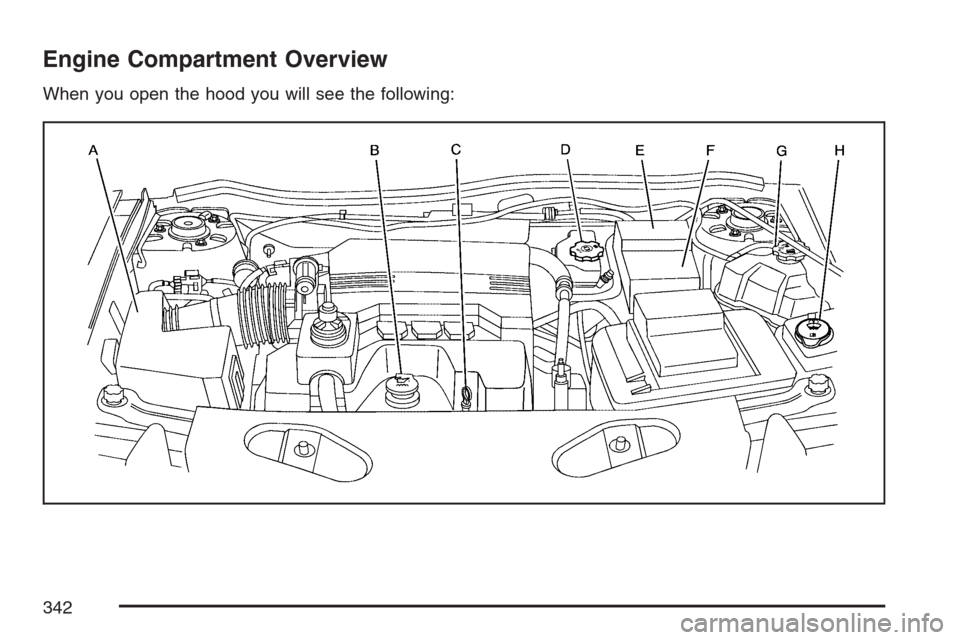
Engine Compartment Overview
When you open the hood you will see the following:
342
Page 343 of 492
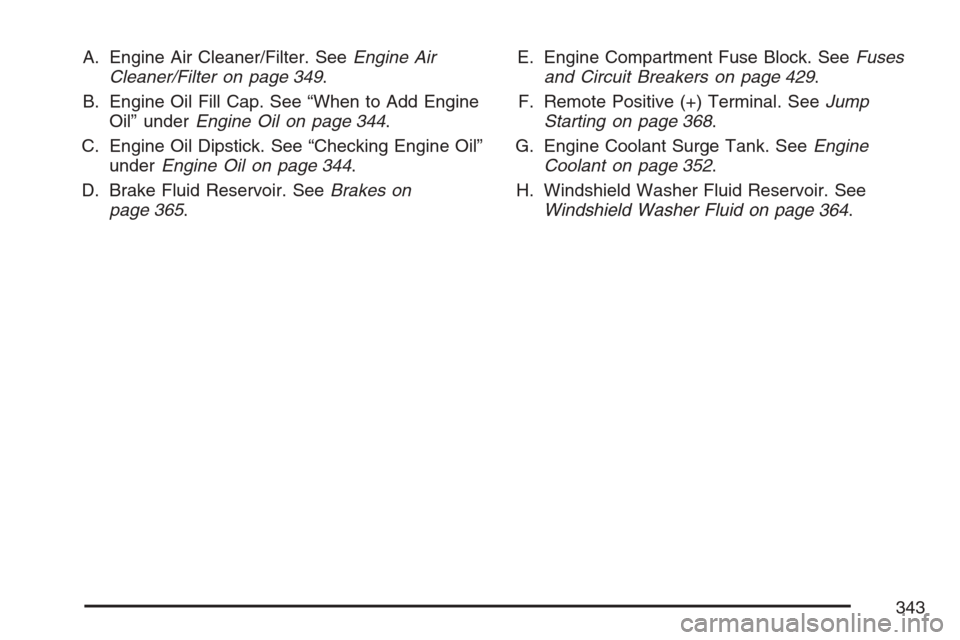
A. Engine Air Cleaner/Filter. SeeEngine Air
Cleaner/Filter on page 349.
B. Engine Oil Fill Cap. See “When to Add Engine
Oil” underEngine Oil on page 344.
C. Engine Oil Dipstick. See “Checking Engine Oil”
underEngine Oil on page 344.
D. Brake Fluid Reservoir. SeeBrakes on
page 365.E. Engine Compartment Fuse Block. SeeFuses
and Circuit Breakers on page 429.
F. Remote Positive (+) Terminal. SeeJump
Starting on page 368.
G. Engine Coolant Surge Tank. SeeEngine
Coolant on page 352.
H. Windshield Washer Fluid Reservoir. See
Windshield Washer Fluid on page 364.
343
Page 344 of 492
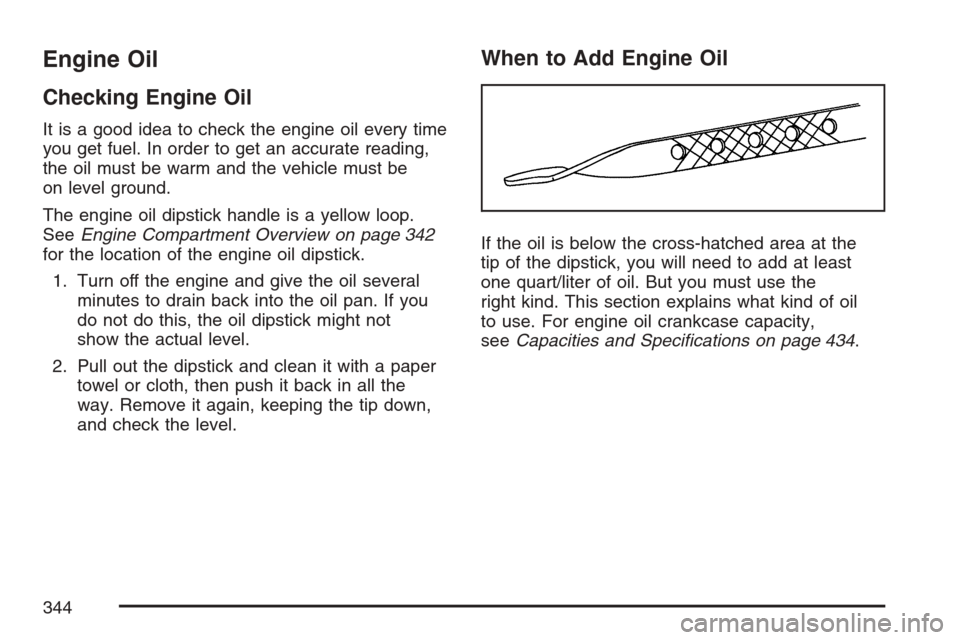
Engine Oil
Checking Engine Oil
It is a good idea to check the engine oil every time
you get fuel. In order to get an accurate reading,
the oil must be warm and the vehicle must be
on level ground.
The engine oil dipstick handle is a yellow loop.
SeeEngine Compartment Overview on page 342
for the location of the engine oil dipstick.
1. Turn off the engine and give the oil several
minutes to drain back into the oil pan. If you
do not do this, the oil dipstick might not
show the actual level.
2. Pull out the dipstick and clean it with a paper
towel or cloth, then push it back in all the
way. Remove it again, keeping the tip down,
and check the level.
When to Add Engine Oil
If the oil is below the cross-hatched area at the
tip of the dipstick, you will need to add at least
one quart/liter of oil. But you must use the
right kind. This section explains what kind of oil
to use. For engine oil crankcase capacity,
seeCapacities and Speci�cations on page 434.
344
Page 345 of 492
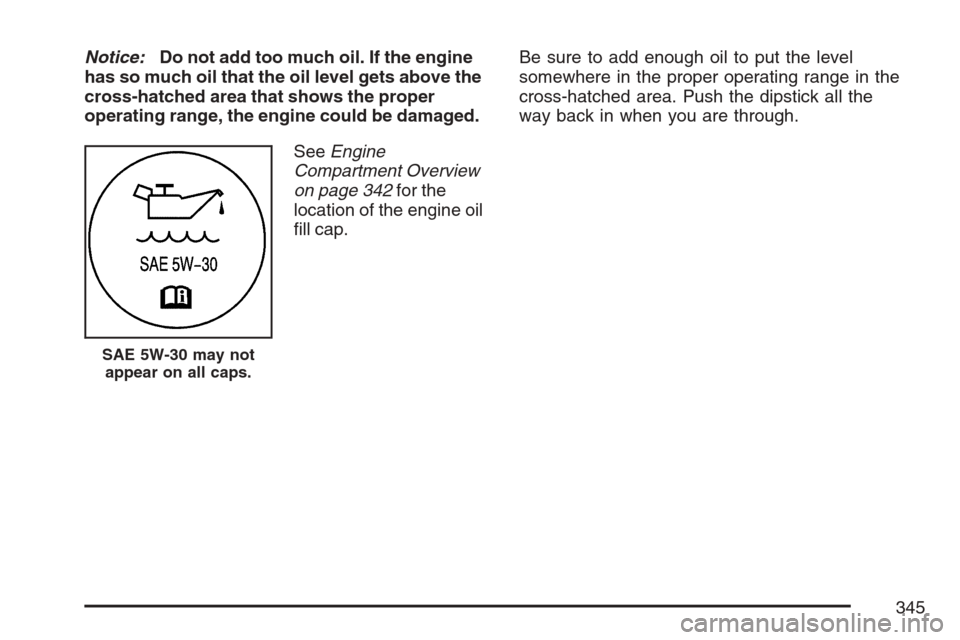
Notice:Do not add too much oil. If the engine
has so much oil that the oil level gets above the
cross-hatched area that shows the proper
operating range, the engine could be damaged.
SeeEngine
Compartment Overview
on page 342for the
location of the engine oil
�ll cap.Be sure to add enough oil to put the level
somewhere in the proper operating range in the
cross-hatched area. Push the dipstick all the
way back in when you are through.
SAE 5W-30 may not
appear on all caps.
345
Page 346 of 492
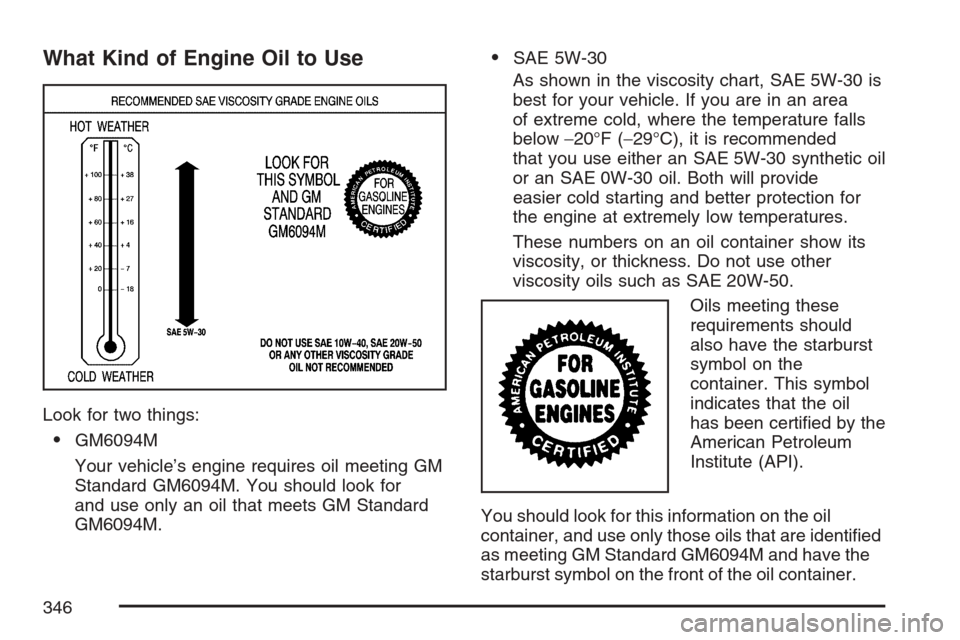
What Kind of Engine Oil to Use
Look for two things:
GM6094M
Your vehicle’s engine requires oil meeting GM
Standard GM6094M. You should look for
and use only an oil that meets GM Standard
GM6094M.
SAE 5W-30
As shown in the viscosity chart, SAE 5W-30 is
best for your vehicle. If you are in an area
of extreme cold, where the temperature falls
below−20°F (−29°C), it is recommended
that you use either an SAE 5W-30 synthetic oil
or an SAE 0W-30 oil. Both will provide
easier cold starting and better protection for
the engine at extremely low temperatures.
These numbers on an oil container show its
viscosity, or thickness. Do not use other
viscosity oils such as SAE 20W-50.
Oils meeting these
requirements should
also have the starburst
symbol on the
container. This symbol
indicates that the oil
has been certi�ed by the
American Petroleum
Institute (API).
You should look for this information on the oil
container, and use only those oils that are identi�ed
as meeting GM Standard GM6094M and have the
starburst symbol on the front of the oil container.
346
Page 347 of 492
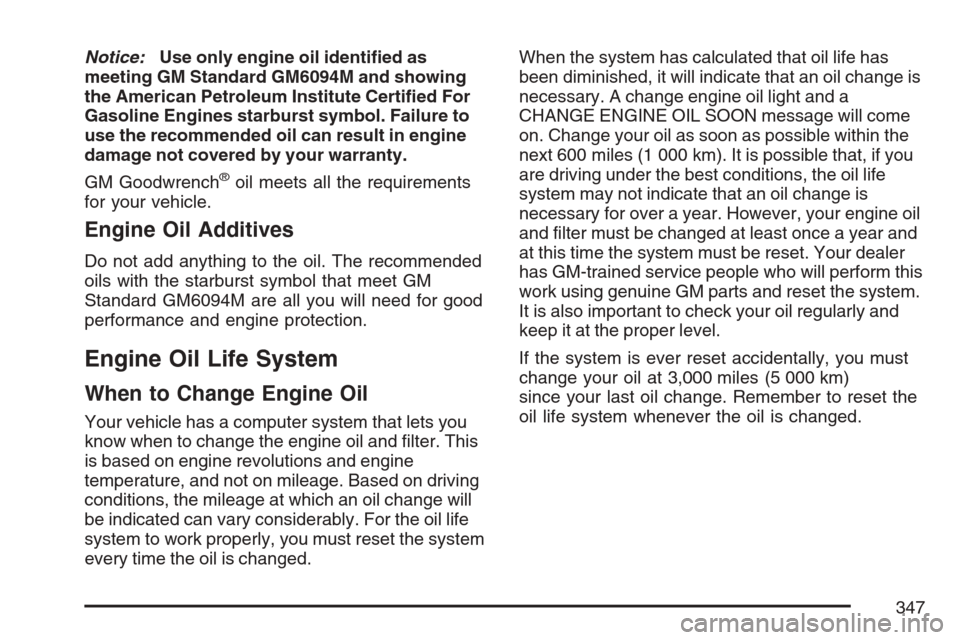
Notice:Use only engine oil identi�ed as
meeting GM Standard GM6094M and showing
the American Petroleum Institute Certi�ed For
Gasoline Engines starburst symbol. Failure to
use the recommended oil can result in engine
damage not covered by your warranty.
GM Goodwrench
®oil meets all the requirements
for your vehicle.
Engine Oil Additives
Do not add anything to the oil. The recommended
oils with the starburst symbol that meet GM
Standard GM6094M are all you will need for good
performance and engine protection.
Engine Oil Life System
When to Change Engine Oil
Your vehicle has a computer system that lets you
know when to change the engine oil and �lter. This
is based on engine revolutions and engine
temperature, and not on mileage. Based on driving
conditions, the mileage at which an oil change will
be indicated can vary considerably. For the oil life
system to work properly, you must reset the system
every time the oil is changed.When the system has calculated that oil life has
been diminished, it will indicate that an oil change is
necessary. A change engine oil light and a
CHANGE ENGINE OIL SOON message will come
on. Change your oil as soon as possible within the
next 600 miles (1 000 km). It is possible that, if you
are driving under the best conditions, the oil life
system may not indicate that an oil change is
necessary for over a year. However, your engine oil
and �lter must be changed at least once a year and
at this time the system must be reset. Your dealer
has GM-trained service people who will perform this
work using genuine GM parts and reset the system.
It is also important to check your oil regularly and
keep it at the proper level.
If the system is ever reset accidentally, you must
change your oil at 3,000 miles (5 000 km)
since your last oil change. Remember to reset the
oil life system whenever the oil is changed.
347
Page 348 of 492
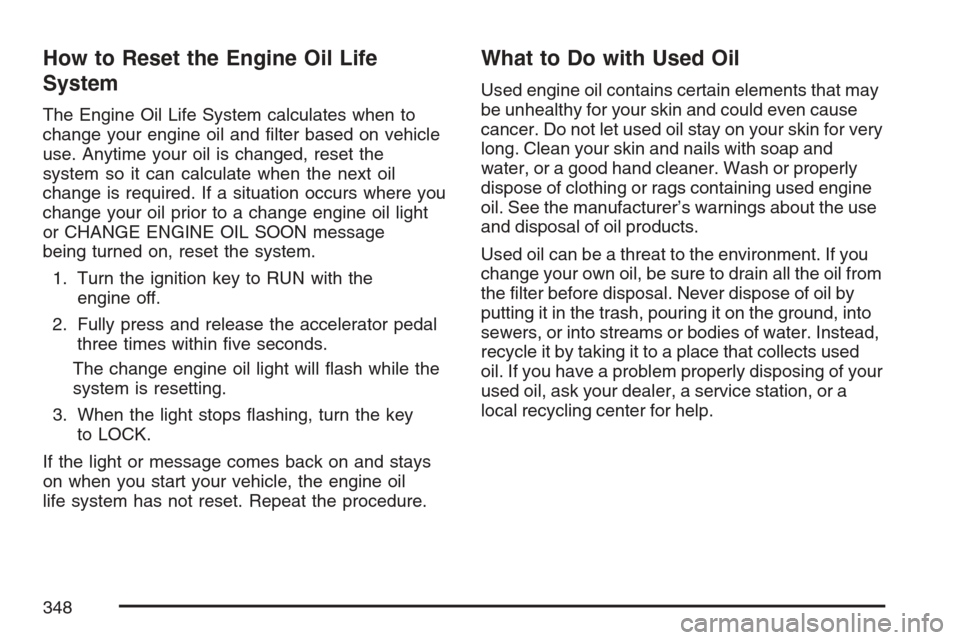
How to Reset the Engine Oil Life
System
The Engine Oil Life System calculates when to
change your engine oil and �lter based on vehicle
use. Anytime your oil is changed, reset the
system so it can calculate when the next oil
change is required. If a situation occurs where you
change your oil prior to a change engine oil light
or CHANGE ENGINE OIL SOON message
being turned on, reset the system.
1. Turn the ignition key to RUN with the
engine off.
2. Fully press and release the accelerator pedal
three times within �ve seconds.
The change engine oil light will �ash while the
system is resetting.
3. When the light stops �ashing, turn the key
to LOCK.
If the light or message comes back on and stays
on when you start your vehicle, the engine oil
life system has not reset. Repeat the procedure.
What to Do with Used Oil
Used engine oil contains certain elements that may
be unhealthy for your skin and could even cause
cancer. Do not let used oil stay on your skin for very
long. Clean your skin and nails with soap and
water, or a good hand cleaner. Wash or properly
dispose of clothing or rags containing used engine
oil. See the manufacturer’s warnings about the use
and disposal of oil products.
Used oil can be a threat to the environment. If you
change your own oil, be sure to drain all the oil from
the �lter before disposal. Never dispose of oil by
putting it in the trash, pouring it on the ground, into
sewers, or into streams or bodies of water. Instead,
recycle it by taking it to a place that collects used
oil. If you have a problem properly disposing of your
used oil, ask your dealer, a service station, or a
local recycling center for help.
348
Page 349 of 492
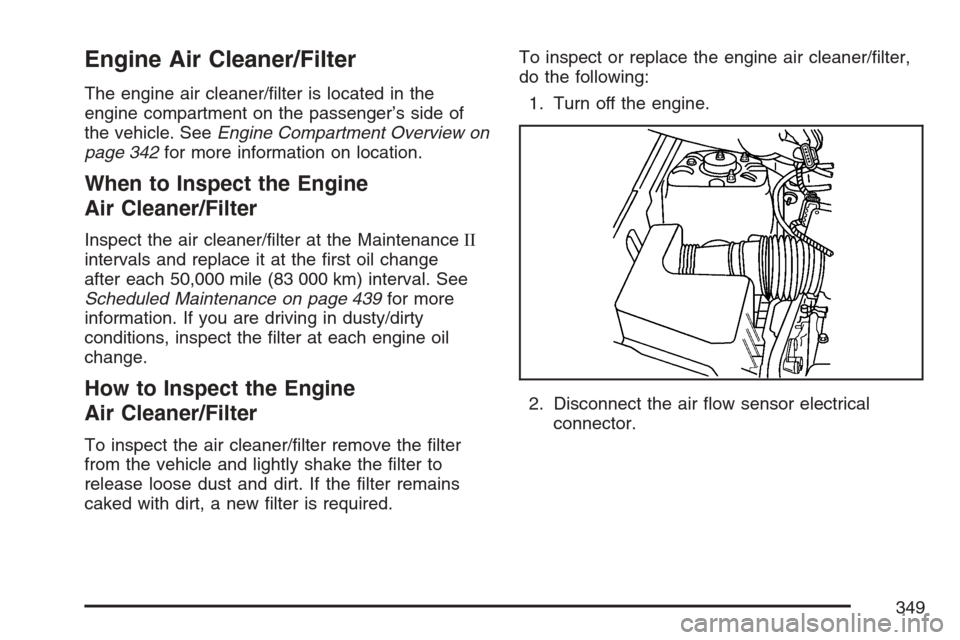
Engine Air Cleaner/Filter
The engine air cleaner/�lter is located in the
engine compartment on the passenger’s side of
the vehicle. SeeEngine Compartment Overview on
page 342for more information on location.
When to Inspect the Engine
Air Cleaner/Filter
Inspect the air cleaner/�lter at the MaintenanceII
intervals and replace it at the �rst oil change
after each 50,000 mile (83 000 km) interval. See
Scheduled Maintenance on page 439for more
information. If you are driving in dusty/dirty
conditions, inspect the �lter at each engine oil
change.
How to Inspect the Engine
Air Cleaner/Filter
To inspect the air cleaner/�lter remove the �lter
from the vehicle and lightly shake the �lter to
release loose dust and dirt. If the �lter remains
caked with dirt, a new �lter is required.To inspect or replace the engine air cleaner/�lter,
do the following:
1. Turn off the engine.
2. Disconnect the air �ow sensor electrical
connector.
349
Page 350 of 492
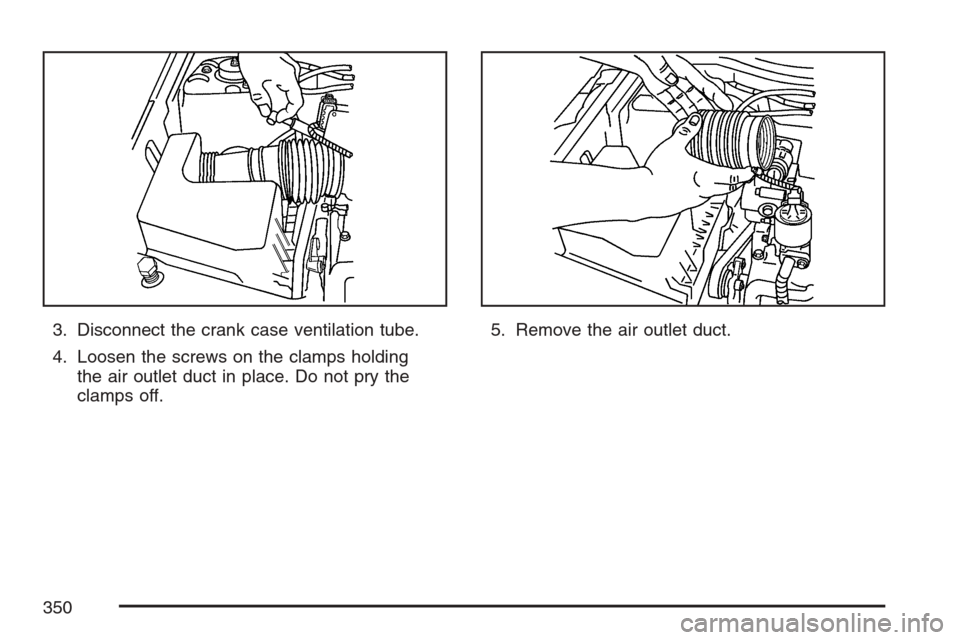
3. Disconnect the crank case ventilation tube.
4. Loosen the screws on the clamps holding
the air outlet duct in place. Do not pry the
clamps off.5. Remove the air outlet duct.
350